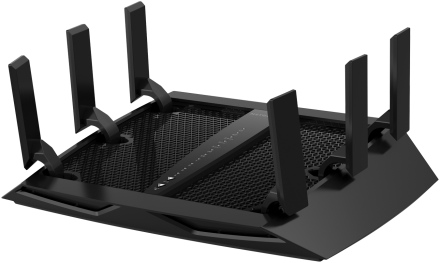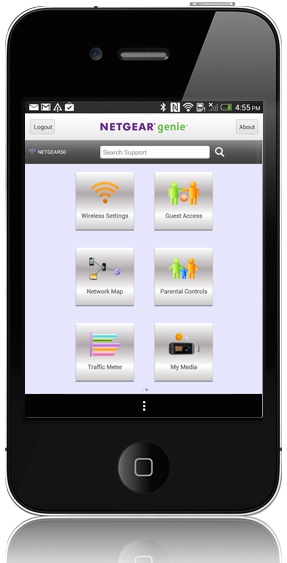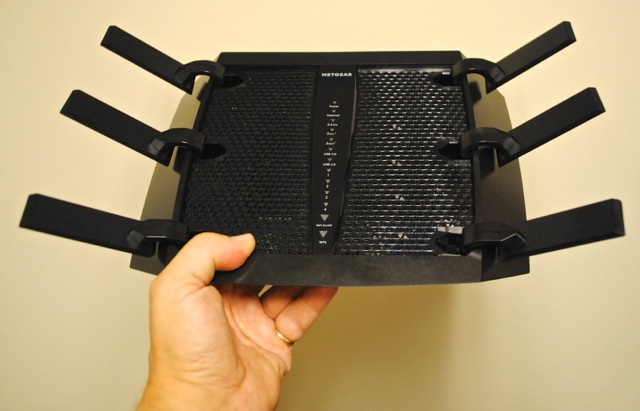
If a growing horde of smartphones, tablets, game consoles, laptops, smart appliances, connected cameras and video streamers is congesting your Wi-Fi network, Netgear has a solution. The Nighthawk X6 Tri-Band Wi-Fi router offers a total of 3.2Gbps over three Wi-Fi bands to maximize the wireless performance of each of those devices. I plugged one in to my home network and here’s how the stealthy looking, six-antenna router performed.
What Is Tri-Band Wi-Fi?
When you first look at the specs, packaging and naming of the Netgear Nighthawk X6 AC3200 Tri-Band Wi-Fi router, the big “3200” stands out. That’s 3200 as in 3200Mbps or 3.2Gbps. It sounds wicked fast and taken at face value would seem to leave other high performance wireless routers released this year —like the Linksys WRT 1900AC (reviewed here)— seem pokey in comparison.
However, 3.2Gbps is not the speed you’re going to get on a connection. The theoretical maximum for a single connected device (assuming you live in a perfect Wi-Fi environment) is 1300Mbps, the same as those dual band 802.11ac routers that max out at 1900 Mbps.
What’s more important when it comes to that name is “Tri-Band.”

Dual-band routers have made a big difference to Wi-Fi networks with multiple devices connected. One device can connect to the 2.4GHz band a second can connect to the 5GHz band so neither device is sharing bandwidth and impacting each other. The Netgear Nighthawk X6 AC3200 Tri-Band Wi-Fi router is one of the first to offer two 5GHz bands, meaning three devices can connect simultaneously at full speed, with two of them having access to 5GHz’s 1300Mbps capability.
The total maximum throughput for the three bands is where that 3.2Gbps comes in.
In real life, you may well have more than 3 wireless devices accessing your Wi-Fi network, so that additional band means the traffic is spread out more, reducing the congestion.
Smart Connect and Beamforming+
The Netgear Nighthawk X6 AC3200 also incorporates advanced technology including Smart Connect, beamforming+ and offers six adjustable, high performance antennas.
Smart Connect automatically negotiates a connection with your devices to ensure they end up on the Wi-Fi band where they’ll see optimal performance. For example, a smartphone capable of the new 802.11ac Gigabit Wi-Fi that connects to your network would be assigned to a 5GHz band so it can take advantage of the higher maximum throughput.
Having six external, adjustable antennas connected to high powered amplifiers means this router can blast a Wi-Fi signal further and at higher strength than most. In a one bedroom apartment, this might not matter so much. In a two story home or a building that suffers from Wi-Fi dead zones, the power makes a noticeable difference. In my own case, my existing older 802.11n router requires a booster to get decent Wi-Fi connection throughout the house. When I swapped it out for the Netgear Nighthawk X6 AC3200, the Wi-Fi signal was strong enough everywhere that a booster was no longer required.
Beamforming+ is another feature that contributes to Wi-Fi range. As the name suggests, beamforming+ actively focuses the Wi-Fi signal between the router and a connected device, giving better range while maintaining a stronger and more reliable signal.
Stealth Look
I can’t talk about this router without mentioning the look. This is a device that you can’t ignore —you’ll probably either love it or hate it. Personally, I think the black wedge with the bristling antennas (clearly reminiscent of stealth military jets) is pretty cool. It definitely looks the part of being the latest in high tech, high performance networking gear.

Netgear Nighthawk X6 Tri-Band Wi-Fi Router Key Specs
|
 Setup
Setup
The antennas fold flat and with a little prying (it would have helped if I’d had fingernails), pop up and swivel for optimal positioning. They’re a little loose and plastic-y feeling compared to others I’ve tested, but once adjusted they remain in position. The router itself has a fairly large footprint (29.5 x 22.7 cm compared to the 16.5 cm square 2011 vintage Apple Airport Extreme I currently use), and with the antennas extended, you will need a bit of space for it.
Configuring the Netgear Nighthawk X6 AC3200 is no different than any other router: basically, you plug it into your modem, power it on, launch a browser (you can connect to it via Wi-Fi or by physically connecting it to a PC with an ethernet cable) and follow the configuration wizard (in this case, the “Netgear Genie”) to set up the network.
The Genie software (also available as an iOS and Android app) offers full network management support, including monitoring, parental controls, printer configuration and troubleshooting.
Performance
Within the house, this turned out to be the speediest Wi-Fi router I’ve tested to date. It had the power to reach the usual challenging spots, despite being placed in the basement.
I always use the Apple TV located in an upper bedroom as a Wi-Fi performance test. Separated from the router location by two floors and a lot of concrete, that AppleTV streams from an iTunes library hosted by a Mac in the basement. With my current setup, the Apple TV has 3/5 bars in terms of signal strength and it takes nearly 40 seconds for it to spool up a 500MB TV show to the point where it begins playing.
That’s with the typical slew of other devices connected and hogging Wi-Fi bandwidth: multiple iPhones, iPads, 3DS and Xbox consoles, other Apple TVs, a smart thermostat and lights, and assorted computers.
With the Netgear Nighthawk X6 AC3200 under the same conditions and no booster, the Apple TV reception improved to 5/5 bars and that wait time between pressing “Play” and having the video actually begin playing was slashed to an average of 5 seconds.
In the house, performance was awesome. In the depths of the back yard (roughly 70 feet), the results were mixed. I usually get one bar on my iPhone when connecting to Wi-Fi from back there. With the Netgear Nighthawk X6 AC3200, the connection wavered between one and two bars. It was a slight improvement, but not dramatic.
Should You Buy It?
As always, this question comes down to whether you are happy with your current Wi-Fi network performance. If you’re starting from scratch, your existing network is feeling congested with all those connected devices or Wi-Fi dead zones in your home are a problem, then the Netgear Nighthawk X6 Tri-Band Wi-Fi router would certainly be a good choice.

If you are adding new devices that take advantage of 802.11ac’s speed, it’s also worth considering as an upgrade since the extra 5GHz band lets more of these connect without having older devices on the network slowing them down. If you’ve recently bought a new dual-band Gigabit Wi-Fi router, it may be tough to justify the expenditure; but if you’re a few years in to an 802.11n router your new devices should see a real boost if you upgrade to the Netgear Nighthawk X6 AC3200.



